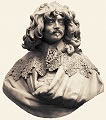|
|
 |
Male
Accessories
|
 |
Gloves were
always worn and belonged to every gentleman's outfit, as well as
muffs, which were worn with a band around the waist, and carried
in front. Very often these fur muffs were rather big.
Walking sticks
remained in fashion as well, and those which had been carried already
in the first half of the century, when the Cavalier outfit
was in fashion, continued to be popular throughout the period.
You will probably
read in several places, that walking sticks became very tall in
the 1660s to become smaller in the 80s again, but I have
looked through all my hundreds of pictures again (14.01.2001) and
I have not found a single example of a walking stick that
was any higher than hip height. In all I found 16 depictions of
gentlemen in the 1660s chapter both in French, English and Dutch
paintings with walking sticks, and they all had the same length,
namely a normal hip height (which is slightly higher than modern
ones.) Therefore I disagree with anyone who says that walking sticks
became very tall in the 1660s, as seen in he wonderful film Restoration,
unless someone can show me at least one example. I believed the
same... until I checked again the first hand evidence of paintings,
engravings, literature and surviving items. It taught me a lesson
(which I should have learnt by now, but...): to never believe anything
face value, but to check everything against first hand evidence!
Furthermore
the smallsword, which was now worn instead of the earlier rapier
by aristocratic civilians, was always on its swordbelt on a courtier's
side, because this often extremely elaborate and elegant weapon
represented the status of a gentleman.

Fabrics,
Colours, Decoration
Although the
cut of the male costume became much more simplified during Louis
XIV's reign, decoration still had its prominent part of importance
in fashion. The more uniform the cut of the coat became, the more
important was the decoration, most of all embroidery, metal laces
and braids. At the same time the hairstyles and the shoes and all
the other fashionable accessories became more and more important
as well.
France was
different to England in the respect that at court in France only
velvets and silks and brocades were worn, in England, on the other
hand, due to the flourishing and exquisite wool industry, fine worsted
wools were just as expensive and as exclusive as the other fabrics.
While in France wools were seen as the more mediocre choice, because
it was worn by commoners, it gained later on once again more importance,
when English fashion came over to France. Court garments were embroidered
all over with gold and silver or silver gilt metal threads (see
for an extant example James, Duke of York's wedding suit from 1673,
V&A Museum, London) sometimes that lavishly that the fabric
wasn't visible anymore.
Expensive laces
belonged to the costume of a fashionable gentleman as well, and
they were worn in abundance. At the cuffs of the shirt sleeves,
and on the cravats, which developed from the collars. Those cravats
either consisted of lace or were richly edged with deep laces. For
further information on lace please refer to the pages dealing exclusively
with laces.

Female
Costumes
Ladies' Baroque Clothing
Indoor
Garments | Footwear | Accessories | Hairstyles | Head-dresses | Development
of the Fontange
Hairstyles
by Vermeer | Dress
Colours by Vermeer | Head-dresses
by Vermeer
Costume Focus Headwear & Neckwear | Costume
Focus Working Women
Costume
Focus Children's Clothing
Ladies'
Costume Quotes
Male
Costumes
Gentlemen's Baroque
Clothing
Indoor
Garments | Footwear | Accessories | Hairstyles | Head-dresses
Costume
Colours by Vermeer | Hair-
and Head-dresses by Vermeer
Gentlemen's
Costume Quotes
~ ~ ~ ~ ~ ~ ~ ~ ~ ~ ~ ~ ~
Embroidery Gallery | Gallery of Needlework
Engravings
Lace Gallery &
Identification | Glossary
Contents © N. Kipar 1997 |









